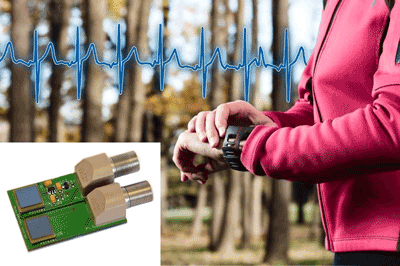Plessey Semiconductors’ EPIC sensor
The development of the Electrical Potential IC (EPIC) sensor is a case study in how academia, government, and industry can come together to improve the public’s general well-being.
The story begins at the dawn of the 21st century, when researchers at the University of Sussex, UK, were looking to solve a measurement problem for fundamental physics research: how to avoid the need for large laboratory electrometers that needed frequent recalibration. Project leader Robert Prance, Professor of Sensor Technology (Engineering and Design) at the University of Sussex, explains that, “we started a blue sky research project that was operating at minus 269C, so we had to invent a measuring technology that was ultra stable, as you could not access it to constantly recalibrate.”

What the researchers came up with is a completely new area of sensor technology, electric potential sensors or EPS, that measures changes in an electric field in a way that’s analogous to how a magnetometer detects changes in a magnetic field; like a magnetometer, the sensor requires no physical or resistive contact to make measurements. The ultra-high input impedance sensor acts as a highly stable, extremely sensitive, contactless digital voltmeter to measure tiny changes in electric fields down to millivolts. There was research into low-voltage electric fields in the 1950s for the creation of photocopiers, but, once perfected, there was very little done. As Prance says, “It was a forgotten area of science until we rediscovered it and realized its huge possibilities.”
Even though the sensor was created initially for measurements in fundamental physics research, Prance remembers that “we quickly realized the many important applications for which this technology could be utilized.” In April 2002, Prance and his colleagues received a grant of £1,033,868 from the royal-chartered Engineering and Physical Sciences Research Council (EPSRC) to develop the sensor and turn it into the basis for a major instrumentation and imaging technology. The team then developed laboratory prototypes for devices that would let doctors monitor patients’ hearts as well as ones to test carbon composite aircraft parts and microchips, and in 2007 received further funding from the EPSRC to investigate many areas for which EPS technology could be adapted, including other aspects of medical science, aviation, microchip manufacture, and the automotive industry.
By the fall of 2010, the work had progressed to the point where it was ready for commercialization, so the University teamed up with Plessey Semiconductors. When the venture was announced on November 10 of that year, Keith Strickland, Technology Director for Plessey Semiconductors, said, “The EPS technology created by Professor Prance’s team at the University of Sussex is a significant innovation that will have a wide-ranging disruptive impact in the sensor market. In conjunction with the University of Sussex, Plessey will be developing an exciting range of EPS sensors utilizing our in-house expertise in semiconductor process technology and design. In particular, our expertise with CMOS image sensors will enable us create very large chips with arrays of EPS sensors. We expect to have our first product prototype available in Q3 of next year for a medical diagnosis product that will significantly advance the ease and quality of cardiac measurements.”
Indeed, in the fall of 2011, Plessey introduced the EPIC medical sensors, for which the company received the Product of the Year Award. And At Sensors Expo this month in Rosemont, IL, Plessey will demonstrate a wristwatch that incorporates EPIC sensors to provide electrocardiagraphs on the go.
Richard Comerford
Advertisement
Learn more about Plessey Semiconductors





